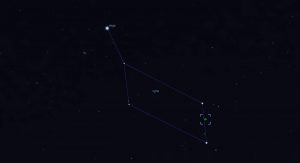Messier 57: the Ring Nebula
Messier 57, known as the Ring Nebula, is one of the most fascinating objects in the Messier catalog and a favorite among amateur astronomers. Located in the constellation Lyra, this planetary nebula is a visual spectacle that combines beauty with a fascinating account of stellar evolution.
Main image: NASA, ESA and the Hubble Heritage (STScI/AURA)-ESA/Hubble Collaboration
¿What is M57?
M57 is a planetary nebula formed when a star similar to our Sun, in the final stages of its life, expels its outer layers after exhausting its nuclear fuel. What remains in the center is a white dwarf, an extremely dense and hot star that illuminates the expelled layers of gas, creating a bright ring that gives it its name.
Main characteristics
- Apparent size: 1.4 x 1 arcminute, making it small but bright.
- Magnitude: 8.8
- Coordinates: Right ascension 18 h 53 m 35 s, declination +33º 01′ 45″. It is perfect for observers in the Northern Hemisphere in summer.
- Diameter: 0.9 light-years
- Age: Between 6,000 and 8,000 years
- Distance: 2,300 light-years from Earth
- Object type: Planetary nebula
Curiosities of M57
The planetary nebula M57, also known as the Lyra Ring Nebula, was first observed in 1779 by Antoine Darquier de Pellepoix. Shortly after, Charles Messier added it to his famous catalog.
To the naked eye or through small telescopes, M57 appears as a simple ring in the sky. However, modern observations with advanced instruments such as the Hubble Space Telescope have revealed an astonishingly complex internal structure. This nebula exhibits an intricate network of gas filaments, dense knots, and multiple concentric layers. This complexity offers astronomers a unique opportunity to study the dynamics of planetary nebulae.
M57 is not just a visual spectacle; it also gives us a fascinating glimpse into the future of our own Sun. Scientists estimate that, in approximately 5 billion years, our star will evolve into a planetary nebula very similar to M57. Studying this nebula helps us understand the life and death processes of stars, including the eventual fate of our solar system.

Image credit. NASA/JPL-Caltech/J. Hora (Harvard-Smithsonian CfA)
Observing M57
The Ring Nebula (M57) is a true treasure for amateur astronomers, offering a rewarding view even with modest equipment. Its brightness and compact size make it an ideal target, even if there is some light pollution in your sky.
How to see the Ring Nebula
With a 4-inch telescope or larger, the Ring Nebula begins to reveal its characteristic ring shape. You’ll see a darker center, like a hole in the sky, surrounded by a glowing halo of ionized gas. If you’re lucky enough to have a more powerful instrument, you’ll be able to see more details of the planetary nebula.
How to locate M57 in the sky
To find this cosmic gem, first look for the constellation of Lyra, easily identified by its brightest star, Vega.
The Ring Nebula is cleverly positioned between the stars Sulafat and Sheliak, which are part of Lyra’s distinctive parallelogram. An astronomy app or a celestial map are tools that will be very helpful in locating it for the first time.

Location of M57 within the constellation Lyra.
Tips
- Use an OIII filter to enhance the nebula’s details in medium-sized telescopes.
- Observe on moonless nights and from a location with little light pollution to best capture the details.
- If you do astrophotography, M57 is a rewarding target: with long exposures, you can capture the colors and external structure of the nebula.
Structure and Colors
Although it looks like a simple ring from Earth, M57 is actually a complex three-dimensional structure, like a cylinder or doughnut seen face-on.
It contains a main ring of bright gas, a fainter outer halo, and a central white dwarf that illuminates everything. Observations reveal concentric layers and knots, indicating multiple gas ejections.
Its colors are key: the vibrant green is due to ionized oxygen, while the reddish hues (visible in photographs) come from hydrogen and nitrogen. These colors appear when the white dwarf’s ultraviolet radiation excites the gases.
M57 is a classic example of a planetary nebula, formed when a star similar to our Sun exhausts its fuel, expels its outer layers, and leaves behind a white dwarf. It is a window into the future of our own Sun, which in about 5 billion years will form a similar nebula. Studying M57 helps us understand the evolution and fate of stars.

 Español
Español
